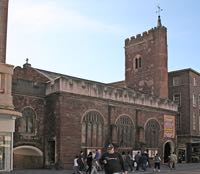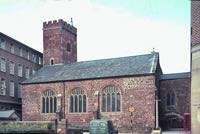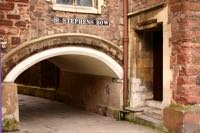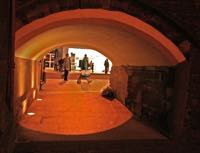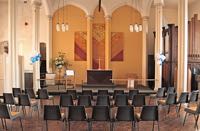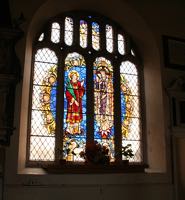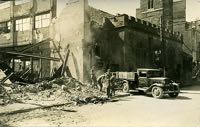
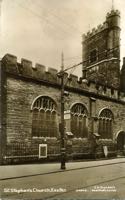 St
Stephen's Church, High Street
St
Stephen's Church, High Street
Page updated 16th February 2018
St Stephens Church on the High Street in central Exeter, may have been built by a wealthy patron for the use of his family. The church was first mentioned in the 1086 Domesday book, although the crypt, unearthed in the 19th century is probably of Saxon origin. Sited on the mid-point of what is now the High Street, it is thought that its position may be owed to the Roman layout of the city. It was opposite a medieval guildhall, pre-dating the present structure further along the High Street.
The church plate of several parishes, including St Stephen's was appropriated, in 1551, for the purpose of "bringing up the River of Exe", or improve navigation to the quay. In 1658, Cromwell decreed that thirteen churches in Exeter be closed and "... the towers of the churches were to be taken down 'clean to the roof by the purchasers and to be converted either into schools or burying places.' " apart from four. St Stephen's drew the short straw and was sold to Toby Allen for £230, to be used as a stable.
Four years later, when the monarchy was restored, St Stephen's was in the process of restoration at a cost of £500 when it was destroyed by fire. In 1664, the people of the parish rebuilt the church, financed by city merchant and alderman, George Potter. A portrait of Charles I that survives, was probably hidden by parishioners during the Commonwealth.
To help pay for the repairs to the church Alderman George Potter Esq left the sum of £500 towards the cost. Thomas Bridgeman also bequeathed a sum of £100 for the work. In 1672, John King, merchant left £125 for the Poor of the Parish to be lent on good security, or be used to purchase or lease lands and the profits used an an appropriate way.
The tower, which was surmounted by an small octagonal tower, had three bells. They were dated 1625, 1635 and 1673 respectively. A small crypt was discovered in May 1826, in which was found two stone columns, about 5 ft 6 inches (1.67 metres) high. One was highly decorated with scroll work and one rather plain, and may have been Saxon in age, although modern archaeologists are not so sure. It was thought to be the cellar that was referred to in the sale to Toby Allen in 1658. The top of a blocked up arched entrance in the wall of the church in Catherine Square is thought to be in line with the space, and was the entrance to the crypt. In the same year Joseph Rowe, a joiner by trade, re-roofed and remodelled the church, and seating for 350 was provided.
The tower was again repaired in the nineteenth-century when a mortgage was taken out for £100 to pay for the work. The interior was also given a Victorian makeover and an octagonal neo-Gothic font installed, along with skylights, as light was blocked by the many buildings against it.
Damaged by incendiary
The building appeared to be largely unscathed during the bombing of May 1942 apart from a fire which caused the bells to fall to the base of the tower. They were shattered, but the bronze from their remains have been recast into a new bell. However, in July 2007, contractors who had stripped the roof tiles in preparation for restoring the church roof were surprised to find the roof timbers showed considerable fire damage, and in some places, were mostly charcoal. Further investigation indicated that after the bombing of May 1942, the roof had caught fire, unbeknown to anyone, and smoldered for many months, or even years before naturally burning out.
The Victorian fittings in the church were removed in 1972 and the building opened up into a space for community use. The room over the ancient bow was made into a meeting room and a small kitchen installed in the north-east corner. Situated in the High Street, St Stephen's is now part of the Central Exeter Parish. It offers the weary shopper, coffee, charitable events and exhibitions during the day. There is an appeal for funds to restore the interior of the church, and plans to open up the area behind the altar, that is over St Stephens Bow, and also to install a glass observation panel in the floor to allow the crypt to be viewed.
Transcripts of the church records dating back to 1668 are available from the Devon Records Office.
Source: White's 1850, Kelly's 1897, The history and description of the city of Exeter By Alexander Jenkins, The Gentleman's Magazine By John Nichols, Lives of the bishops of Exeter, and a history of the cathedral, with an ... by George Oliver, J S. Attwood.
│ Top of Page │
